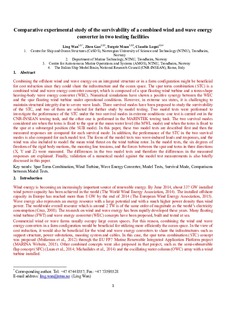| dc.contributor.author | Wan, Ling | |
| dc.contributor.author | Gao, Zhen | |
| dc.contributor.author | Moan, Torgeir | |
| dc.contributor.author | Lugni, Claudio | |
| dc.date.accessioned | 2017-10-25T07:57:25Z | |
| dc.date.available | 2017-10-25T07:57:25Z | |
| dc.date.created | 2015-12-04T13:37:18Z | |
| dc.date.issued | 2016 | |
| dc.identifier.citation | Ocean Engineering. 2016, 111 82-94. | nb_NO |
| dc.identifier.issn | 0029-8018 | |
| dc.identifier.uri | http://hdl.handle.net/11250/2462019 | |
| dc.description.abstract | Combining the offshore wind and wave energy on an integrated structure or in a farm configuration is beneficial for cost reduction since they could share the infrastructure and the ocean space. The spar torus combination (STC) is a combined wind and wave energy converter concept, which is composed of a spar floating wind turbine and a torus-shape heaving-body wave energy converter (WEC). Numerical simulations have shown a positive synergy between the WEC and the spar floating wind turbine under operational conditions. However, in extreme sea states, it is challenging to maintain structural integrity due to severe wave loads. Three survival modes have been proposed to study the survivability of the STC, and two of them are selected for further study by model testing. Two model tests were performed to investigate the performance of the STC under the two survival modes in extreme conditions: one test is carried out in the CNR-INSEAN towing tank, and the other one is performed in the MARINTEK towing tank. The two survival modes considered are when the torus is fixed to the spar at the mean water level (the MWL mode) and when the torus is fixed to the spar at a submerged position (the SUB mode). In this paper, the two model tests are described and then the measured responses in the two model tests are compared for each survival mode. In addition, the performance of the STC in the two survival modes for each model test is also compared. The differences in the two model tests are explained in detail. The focus of the model tests was wave-induced loads and responses, and wind was also included to model the mean wind thrust on the wind turbine rotor. In the model tests, the rigid body motions in six degree of freedom, the mooring line tensions, and the forces between the spar and torus in three directions (X, Y and Z) were measured. Finally, validation of a numerical model against the model test measurements is also briefly discussed. | nb_NO |
| dc.language.iso | eng | nb_NO |
| dc.publisher | Elsevier | nb_NO |
| dc.rights | Attribution-NonCommercial-NoDerivatives 4.0 Internasjonal | * |
| dc.rights.uri | http://creativecommons.org/licenses/by-nc-nd/4.0/deed.no | * |
| dc.title | Comparative experimental study of the survivability of a combined wind and wave energy converter in two testing facilities | nb_NO |
| dc.type | Journal article | nb_NO |
| dc.type | Peer reviewed | nb_NO |
| dc.description.version | acceptedVersion | nb_NO |
| dc.source.pagenumber | 82-94 | nb_NO |
| dc.source.volume | 111 | nb_NO |
| dc.source.journal | Ocean Engineering | nb_NO |
| dc.identifier.doi | 10.1016/j.oceaneng.2015.10.045 | |
| dc.identifier.cristin | 1297063 | |
| dc.relation.project | Norges forskningsråd: 223254 | nb_NO |
| dc.description.localcode | This is the authors' accepted and refereed manuscript to the article. Locked until 17 November 2017 due to copyright restrictions. | nb_NO |
| cristin.unitcode | 194,64,20,0 | |
| cristin.unitname | Institutt for marin teknikk | |
| cristin.ispublished | true | |
| cristin.fulltext | postprint | |
| cristin.qualitycode | 1 | |

